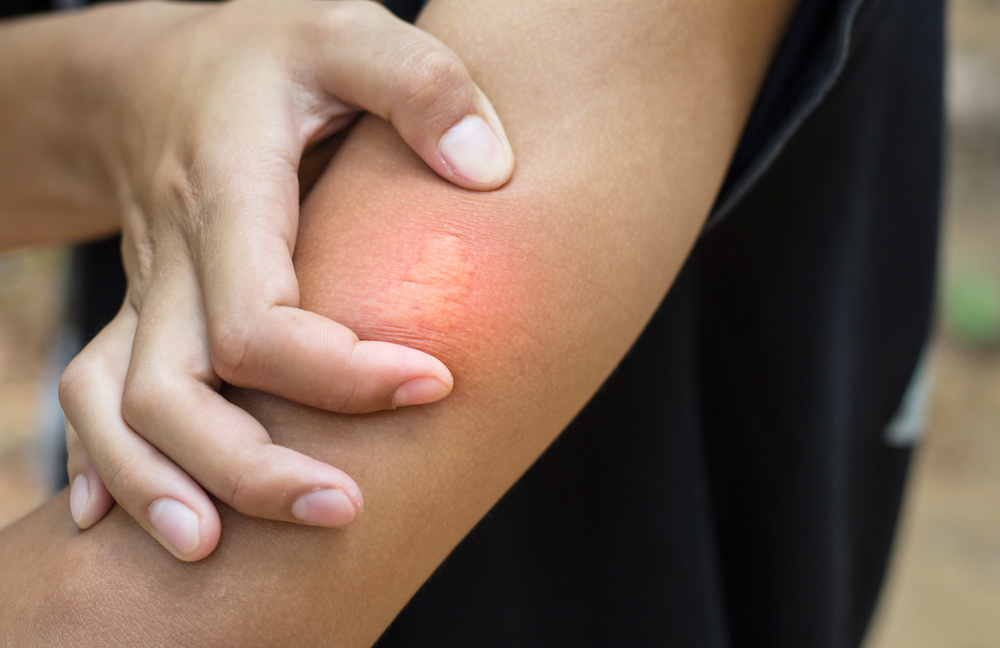How to Treat (and Avoid) Bee Stings

Honeybees are small but mighty creatures. Their stings can be more than unpleasant; they can be downright painful. For those who are allergic to bee venom, bee stings can be life-threatening. That’s why we think it’s better to know how to deal with a bee sting, before one even occurs.
In this article, we are going to talk about what happens when you get stung by a honeybee. Then, we are going to share tips for treating a bee sting, including some natural home remedies using products you likely have in your kitchen.
What Happens When a Bee Stings You?
Most honeybee stings occur when a bee senses that their hive is being threatened. Most worker bees who are out foraging for nectar or pollen are too busy to worry about stinging humans. However, if swatted or annoyed in some way, they may act to protect themselves.
A honeybee’s stinger is barbed. When the stinger enters its victim, the barbs get caught in the skin and retract, pulling the stinger deeper into the skin. Once the stinger is inserted into the victim, the honeybee cannot pull it out. Instead, the stinger and part of the abdomen are left behind. Unfortunately, this kills the honeybee. The stinger releases its venom into the skin as well as certain pheromones that alert other bees in the area of the threat.
How to Treat a Bee Sting
Remove the stinger.
The first thing to do is remove the stinger. The quicker the stinger is removed, the less time there is for the venom to enter the body. The stinger can be removed by using a fingernail or a credit card. For whatever method you choose, the key is to remove the stinger as quickly as possible. Once it is removed, it is smart to leave the area because the pheromones left behind have the potential to attract other bees.
Clean the affected area.
Before applying any medication or ice, it is best to clean the affected area thoroughly with soap and warm water. This can help prevent infection and remove any residual venom that might be on the surface of the skin.
Treat the swelling.
Bee stings often result in redness, swelling, itchiness and pain. After removing the stinger, apply an ice pack to that area. This will reduce any swelling and ease some of the pain and itching. You may also wish to take an antihistamine like Benadryl or an over-the-counter pain reliever like ibuprofen to address any pain.
Call 911 for emergencies.
While most people will experience temporary discomfort from a bee sting, many people are severely allergic to bee venom. Rather quickly, you will notice signs of an allergic reaction such as extreme swelling, hives, vomiting and difficulty breathing. If the person knows they are allergic to bee stings, hopefully they have an EpiPen handy. If not, call emergency medical professionals right away for the appropriate treatment.
Natural Remedies for Bee Stings
For those who are not severely allergic to bee stings, there are items that you may have lying around your kitchen that can help decrease the swelling, itchiness or discomfort associated with the sting. Some of the most common natural at-home remedies include:
Honey: antibacterial properties to help the wound heal
Baking soda: neutralizes venom and reduces pain and itchiness
Apple cider vinegar: neutralizes the venom and reduces pain
Aspirin: wet aspirin applied directly to the sting can reduce pain and swelling
Aloe vera: soothes the skin and relieves pain from a bee sting
Lavender essential oil: anti-inflammatory and can help with swelling
Tea tree oil: antiseptic properties and can prevent infection
Witch hazel: soothes the skin and reduces inflammation
Tips for Avoiding Bee Stings
During bee season, there is a higher chance of getting stung. Although you may not be able to avoid it entirely, there are things you can do to help decrease your chances of getting a bee sting.
- Always wear shoes when walking outdoors in the grass.
- Never mess with a beehive or swarm.
- Avoid flowery perfumes or sweet-smelling lotions.
- Check beverage cans and bottles before taking a sip.
- Cover food when eating outdoors.
- Avoid wearing bright colors or flowery prints that can attract honeybees.
By following the tips above, you can significantly decrease your risk of getting an unwanted bee sting. However, if you do experience a sting, treat it right away by following the tips above. If you notice any signs of a severe reaction, call 911 for medical attention right away.
D-Tek Live Bee Removal specializes in safe and humane bee removal services for San Diego and the surrounding communities. We are proud to work with local apiaries to preserve and protect the honeybee population while keeping your home and business safe.
